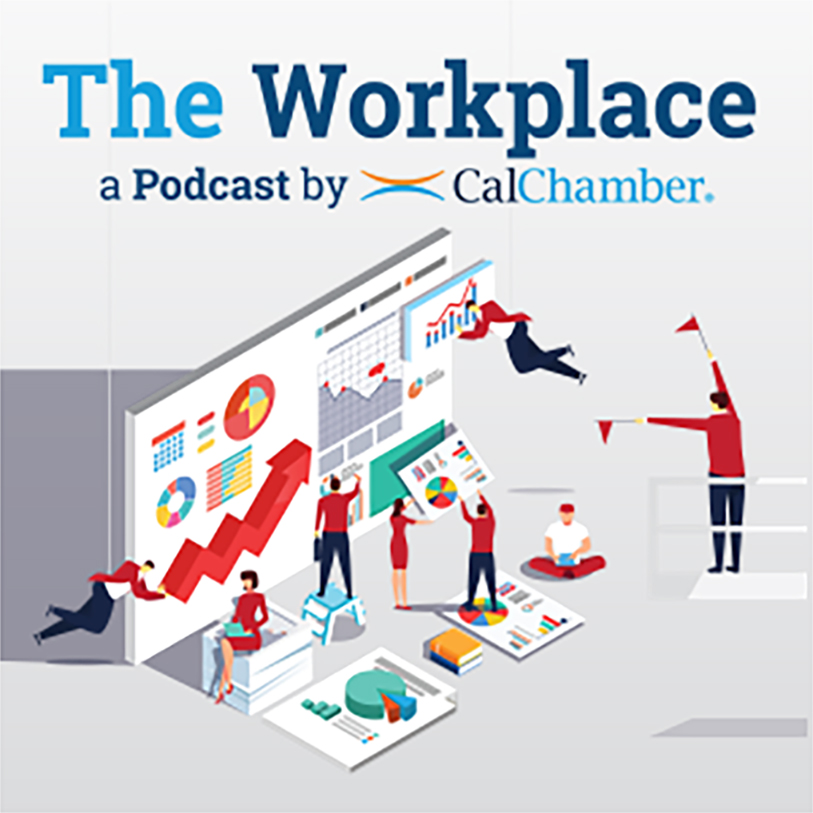In this episode of The Workplace podcast, CalChamber employment law expert Matthew Roberts is joined by best-selling author and recruiting expert Rikka Brandon to discuss the importance of succession planning and steps to get the process underway.
Declining birthrates over the last few generations have left a recruitment gap that makes succession planning an even greater priority for companies.
While many company leaders understand the importance of succession planning, many put it off, Brandon says. However, in the last year or two, it has suddenly become more urgent with unexpected resignations and early retirements during the COVID-19 pandemic and as baby boomers are starting to leave the workforce.
Brandon notes that succession planning can be a very emotional and political process. In some situations, employers might find themselves in tricky situations when an employee who believes they might be next in line for a particular position just doesn’t have the skills necessary to thrive in the role. Employers must work to manage employee expectations, and this can be tricky when employers really like their employees and want what’s best for them.
Preparing for Unexpected Retirements
Brandon points to the many unexpected retirements that happened during the pandemic as a call to action for succession planning. In the podcast, Brandon points to examples of 30-year employees giving 30-day or even 3-day notice when their employers thought these individuals would continue working for another 3–5 years. Rapid departures left employers with no time to capture the knowledge of the departing employee or hire a qualified replacement.
Maintaining Open Communication
Brandon recommends keeping an open channel of communication with employees and doing regular “temperature checks.” People are not often sure of what their exact retirement date will be, as most don’t have one picked in advance.
Employers, of course, want to keep top performers as long as they can, and with that it is also important to offer employees more flexibility. Brandon says offering employees more time off might allow them to continue working longer with a reduced schedule that allows them to stay with the company longer.
In the podcast, Brandon underscores the need for succession planning in terms of protecting the longevity and the future of the company. She shares a story of one company that had two employees with more than 100 years combined experience at the company, pointing out that more likely than not, two new workers could not capably replace those two retiring employees, and it would more likely require four to five people to replace them.
4 Simple Steps
Brandon says there a few simple steps that a company can take to move the succession planning process forward, in addition to hiring a consultant. These include:
- Having a clear vision on your business. Often people think there has to be a grandiose or complicated plan, but it is OK to have a plan that sticks to the status quo. The most important thing should be business continuity. Brandon notes that if a company has a vision of expanding or diversifying, that of course should be a part of the plan, but the first step of the plan should be for business as-is to continue. Brandon says to be clear about a goal and move toward it.
- Identifying key roles. Key roles aren’t exclusive to owners and leaders, giving the example of a salesperson who control 50% of the revenue for a company. Identify anyone who plays a key role in your business and understand what needs to be replaced if that person were to leave.
- Performing a SWOT (Strengths, Weaknesses, Opportunities and Threats) analysis, and documenting it on paper. Brandon notes that in a perfect world this would be done role by role, but it is hard to do when someone has been in a role 10+ years. Start by laying out the SWOT for the role, and understand that it will likely bleed into being about the person who fills that role as well. Think from the perspective of business needs first, what does the business need now and the future as it pertains to that role.
- Capturing know-how and knowledge. Especially for employees who have been at a company for 10+ years, there is a need to document as much of what is in the employee’s head as possible. This is yet another tricky process, Brandon acknowledges. Knowledge is not just how to do something, but the decision-making behind it. Knowledge is made up of experience, education and instinct. It is good to remind veteran employees to share their thinking and rationale for decision making.
Build a Framework and Adapt
Brandon suggests creating a checklist or a master document to facilitate the succession planning process, noting the most important part is just to start, as doing something is better than nothing. Succession plans are fluid living documents — they can serve as a framework or guide — but employers can’t predict the future and need to adapt to changing realities.
Brandon emphasizes that the most important part of succession planning may be simply to take action. A succession plan does not need to be perfect; it can be improved down the road, but it is important to start the process. Brandon reminds employers that recruitment and retention are two sides of the same coin. Succession planning gives a company and its long-term employees an important path forward.
CalChamber members can read more about Recruiting Employees in the HR Library. Not a member? See what a CalChamber membership can do for you.




